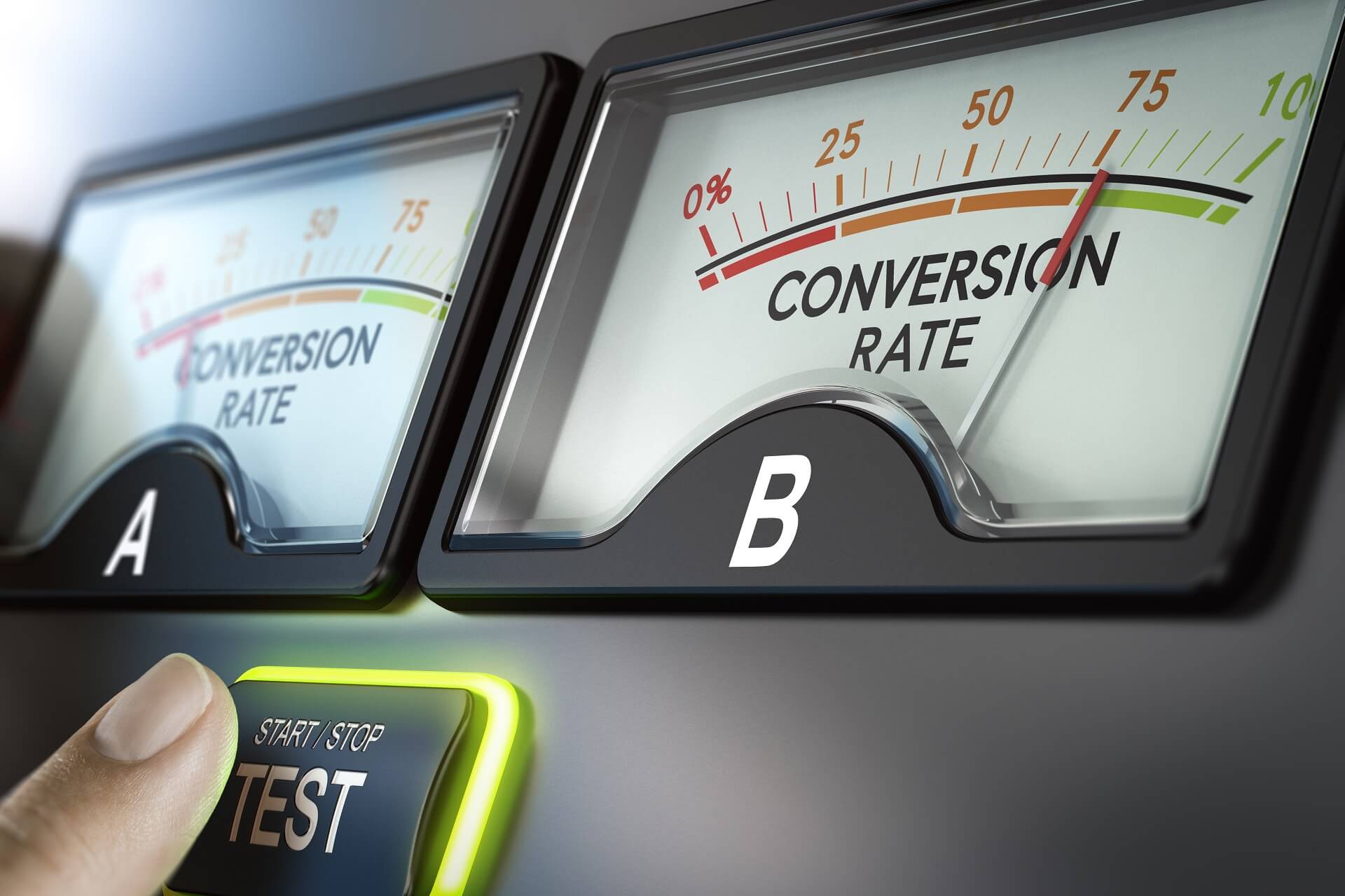A lot of marketers are confused about whether they should conduct A/B tests or multivariate tests on their web pages, mobile apps, emails, and opt-in forms.
All you hear online is that you should ‘keep testing and optimizing your pages’, but it isn’t always clear which type of test you should be running on your different pages to maximize conversions from your marketing strategies.
In this article, we’ll take a look at the differences between these two conversion optimization methods, as well as the pros, cons, and use cases of each so you can determine the best way to use each one.
So read on to discover everything you need to know about how to use multivariate and A/B testing to drive your website’s success.
What is A/B Testing?
To gain a better understanding of the differences between A/B and multivariate testing, we’ll first look at the definition, methodology, and common uses of each conversion optimization method.
A/B testing (also called split testing) is an optimization method where you test two different versions of the same page – a control page, and a variation page, to find out which one has the best conversion rate.
To conduct an A/B test, simply divide your traffic evenly. Send 50% of the visitors to the original page and the other 50% to the new variation.
After adequate amounts of live traffic are funneled to each page and an analysis is made according to the way visitors interact with the page version that is shown to them.
For instance, which buttons did the visitors click on? Which videos did they watch? Did they sign up for the website’s newsletter?
Using the information gathered from this test, it becomes easy to determine which version of the page performs the best – the original, or the variation with a changed element. You can also see at a glance how the alterations vary from one page to another.
Some of the elements you can test include:
- Headlines
- Videos
- Graphics
- Layouts
- Buttons
- Fonts
- Offers
- Colors
- Call to action text
- … and so on.
Types of A/B Testing
A/B/n testing is a different version of split testing where you analyze many different versions of the same element on a page. Traffic is divided evenly among the test pages.
For instance, if you want to test four different versions of your headline, you would have to split your traffic into four, with 25% of your total visitors seeing each headline.
A/B Testing Pros
A/B testing comes with a wide range of benefits. Used continuously and consistently, this testing method can significantly improve your user experience and boost your conversion rates both short and long-term.
Here are other advantages of split testing:
- Simple Concept: Simple in design and concept, A/B testing is an extremely reliable way to get insights on the best-performing page versions so you can optimize your marketing strategies.
- Ease of Analysis: This testing method is very easy to interpret, and even larger websites use it as a primary way of testing since it allows them to conduct test cycles one after another, without the need for complex multivariate tests.
- Quick Results: A/B testing delivers results quickly thanks to the small number of variables being tracked. This means that you don’t need large traffic numbers to get accurate data.
A/B Testing Cons
While this conversion optimization method comes with a lot of enticing advantages, it also has a few limitations.
For instance, with A/B testing, there is no way for you to determine exactly how the different elements on each page interact with one another.
You might decide to change the CTA button color, but there could be a different element on that page that also has an impact on your visitors’ response. That’s something that you will not be able to accurately measure using simple A/B tests.
What is Multivariate Testing?
Multivariate testing is different from A/B testing in that you can test multiple combinations of page elements at the same time.
Websites and mobile apps are made using combinations of elements that are changeable. You can alter several different items on each page so that one version looks very different from the other one.
The goal of this testing method is to find out which combination of variations performs better than all other possible combinations.
In multivariate testing, traffic is sent to the different design variations to determine the effectiveness of each design combination so you can achieve the ultimate objective of maximizing conversions.
The same core mechanisms are used in this method of conversion optimization testing as in A/B testing. However, you will be comparing more variables, and this reveals a lot more detailed information about how the different page elements interact with each other.
Types of Multivariate Testing
There are many different types of multivariate tests you can run. Below, we take a look at some of the most commonly used types of tests you can use to get the most from your web pages, mobile apps, emails, opt-ins, and more.
Full Factorial Testing: This is the most common type of MVT testing. It involves testing all the possible variations of pages until one clear winner is found. This type of test requires a lot of traffic which is then divided evenly among all the different page versions.
Fractional Testing: Also called partial factorial testing, this method of conversion optimization only analyzes a fraction of the possible combination of elements. The best-converting page variation from the remaining versions is determined using statistical mathematical calculations.
Adaptive Multivariate Testing: This is a different approach to MVT testing, and it involves analyzing the real-time responses of visitors to a page to determine which version has the best-converting variation of elements.
Multivariate Testing Pros
The benefits of using multivariate tests include:
- Faster Results: Multivariate testing offers faster results than running A/B tests since you can alter and analyze many different elements on one page.
- Targeted Redesign: It allows you to determine the contribution of each element to the measured gains which is great for targeting redesign efforts to the individual page elements where they’re likely to deliver the biggest impact.
- Measure Interaction Effects: With multivariate testing, you’ll be able to measure interaction effects between many supposedly independent page elements, like the visual illustrations, page titles, and so on.
Multivariate Testing Cons
As with A/B testing, multivariate testing also comes with some drawbacks.
For instance, it won’t work if your site has low traffic levels. You must have at least 100,000 monthly visitors before considering this type of conversion optimization testing.
This is because of the high number of combinations that have to be tested to find the best performing page.
Furthermore, the more combinations of page elements that have to be tested, the longer the test will take.
Use Cases of A/B and Multivariate Testing
Now that you have a firm understanding of the two types of conversion rate optimization tests, let’s take a look at a few use cases for both, as well as some examples of how you can use these strategies to drive outstanding results in your business.
Common Uses for A/B Testing
A/B testing is the least complex method to test and evaluate different design elements on a page. It’s useful for a wide range of applications:
Example 1:
You can use split testing as an optimization option to determine which one is the best page variation if you only have one element that’s up for debate.
For instance, a pet shop running an A/B test on one of their pages might find that 78% more visitors sign up for their monthly newsletter when shown a big sign held up by a cartoon hamster as opposed to a sign held up by an actual human.
When conducting A/B tests in this way, you could even add more pages to make it an A/B/n test, and then apportion the traffic evenly to each of the different pages.
Example 2:
Yet another common use for this type of testing is to test page designs that are very different to see which one performs the best.
For instance, you could use A/B tests to analyze the current version of your website’s homepage, which might include elements like images, video, text, and a CTA button.
In your new homepage version, you might remove much of the text, and instead, include a top bar for advertising your business’s latest products. After funneling an adequate number of visitors to each page, you then compare how many clicks you got on each of the different CTA versions.
Note that although you’re changing many design elements on the page, you’d only be tracking the impact that the page as a whole has on your goals for that particular page and not the individual page elements.
Common Uses for Multivariate Testing
The most commonly cited use for this method of testing is pages that have several elements that are in question.
For instance, if you have a page with a compelling header, signup form, call to action, and a footer, you might conduct a multivariate test, instead of creating a page that is very different (as in the split test described above).
So, you could have a couple of signup forms of varying lengths, three footers, and four different headlines. Then, you would drive traffic to all the possible combinations of these elements (aka full fractional testing).
Remember: The higher the number of variations to test, the more traffic you will need to send to the pages, and the longer it will take to get any meaningful results from your multivariate test.
This is the reason why this form of conversion optimization testing is generally recommended for sites that have substantial numbers of daily visitors.
After running the multivariate test, you can then analyze the variables on the different pages to see how they compare to each other. You’ll also be able to determine how well they performed in relation to other variations of the MVT test.
This will give you a clear picture of which page offers the absolute best results, as well as the specific elements responsible for the improvement in performance. For instance, you might find that changing the CTA button color of the page might not have as much impact as altering the headline.
Deciding What Works Best for You
A/B testing and multivariate testing each have their own unique set of pros and cons. The type of testing you choose will depend on your needs. According to Drip Digital, you should ask yourself these two questions.
Do you need an effective way to refine your pages for improved conversions? In that case, A/B testing is the best testing method to use.
Are you looking to test new pages following a website redesign? If so, multivariate testing will help you get all the data you need.
You can choose A/B testing or multivariate testing depending on your needs. You can even make use of both testing methods to get the most from your efforts to optimize your conversion rates.
- A/B tests are simple and quick. They offer bigger gains, particularly for websites with low levels of traffic.
- Multivariate tests offer you an overview of multiple changes. You can then split-test the results to fine-tune each of the elements, individually.
Another method is to use A/B testing to find the best-performing page layout. Once you’ve identified it, use multivariate tests to tweak and improve the interaction between the various page elements.
There are endless options available to you!
Conclusion
Both A/B and multivariate testing can yield powerful insights, but knowing when to use each is key.
A/B testing is excellent for quick, targeted optimizations, while multivariate testing is ideal for exploring and validating more comprehensive design changes. Consider them as two extremely powerful and versatile tools that complement each other to enhance your marketing strategy.
Conversion rate optimization services often provide a suite of testing tools to ensure you’re using the best method for your specific goals, helping you achieve meaningful and measurable improvements in site engagement and conversion rates.
Have you used A/B or multivariate testing to boost your conversion rates? Let us know in the comments below!




